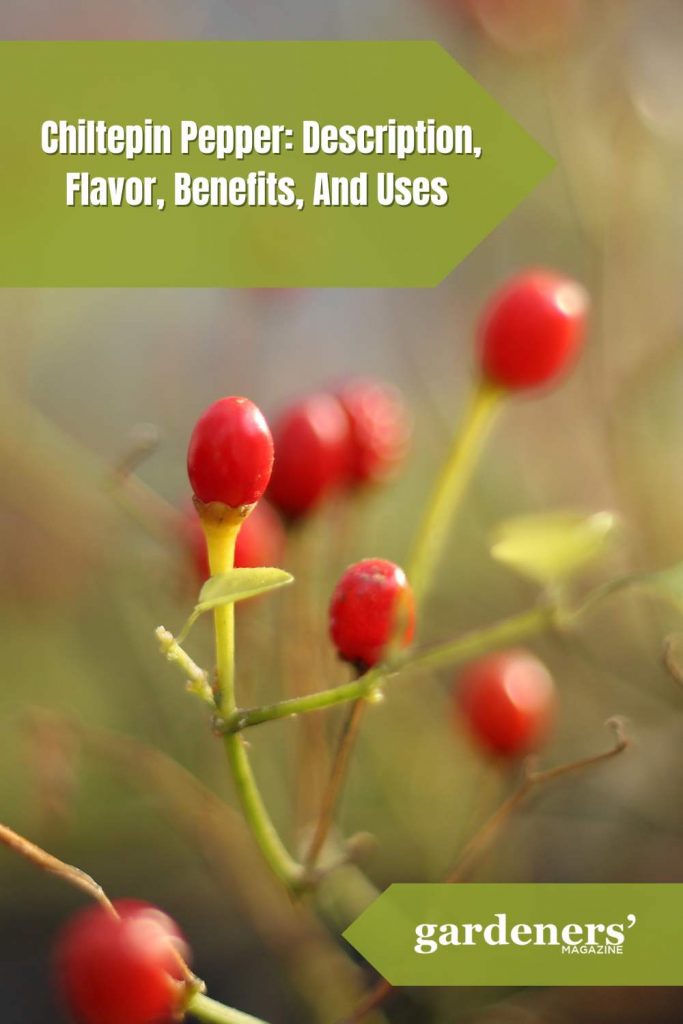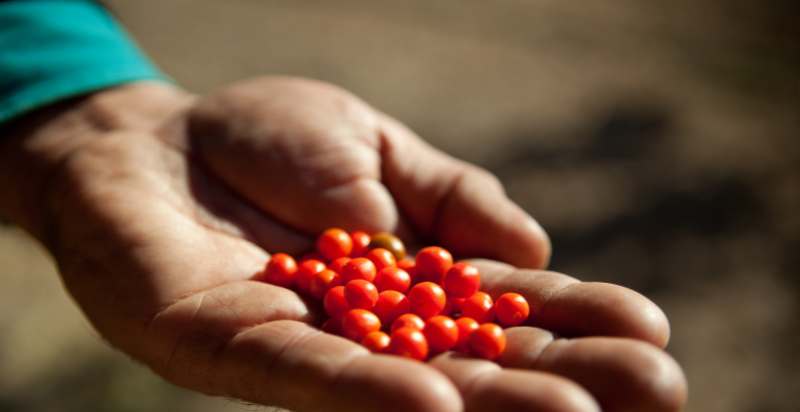The Chiltepin Pepper is a wild pepper native to the Rio Grande Valley region of South Texas and northern Mexico. The ancient cultures that inhabited this area have cultivated it for thousands of years, including the Mayan and Aztec civilizations. Due to its distinctive flavor profile and varied culinary applications, the chiltepin pepper has grown in popularity recently. Here is all the information you need to know about this remarkable pepper.
What is Chiltepin Pepper?
Chiltepin pepper is a wild chile native to northern Mexico and the Southwest United States. It is an ancient variety, believed to be the oldest domesticated pepper in North America. The small round berries are usually bright red when ripe but can also be yellow or orange.
Chiltepin peppers have a unique taste – smoky, earthy, and slightly spicy. It is one of the world’s hottest varieties of wild chile peppers – measuring up to 50,000 on the Scoville Heat Scale.
The Chiltepin pepper is an essential ingredient in traditional Mexican cuisine and is widely used as a condiment or as a seasoning for soups, stews, sauces, and salsas. It also flavors meats, fish, poultry, and vegetables. The Chiltepin pepper is additionally known to have anti-inflammatory qualities and may benefit digestive health.

History and Origin of Chiltepin Pepper:
Chiltepin peppers, known as “bird’s eye peppers,” are the wild ancestor of all modern hot pepper varieties. Native to North America, this small-fruited chili pepper is believed to have originated in Mexico and was later shared with indigenous tribes across the region.
The word ‘Chiltepin’ comes from the Nahuatl language, a group of languages spoken by many indigenous people in Mexico and Central America. In Nahuatl, chilte means “flea” or “hot pepper,” and pin (or pín) means “top.” This refers to the small size of the chiltepin peppers, which are slightly larger than a flea.
Chiltepin peppers have been used by native peoples for thousands of years in traditional dishes and as medicine. The Aztecs believed that eating chiltepins would add years to your life, and they were often part of religious ceremonies and offerings.
Today, chiltepin peppers are still enjoyed in Mexico and Central America, although they can be difficult to find outside the region. They’re often used as a condiment or seasoning—sprinkled on soups, salads, tacos, and more for a smoky flavor.
Description of Chiltepin Pepper:
The Chiltepin Pepper is a small, round pepper that grows to about 1/2 inch in diameter. It ranges in color from red to tan and has a fiery flavor with hints of citrus and smoky notes. The pepper is often called the “mother of all peppers” due to its spiciness. It can range from 30,000 to 50,000 Scoville Heat Units (SHU), making it one of the hottest peppers in the world.
Growing Conditions of Chiltepin Pepper:
Chiltepin peppers are native to Mexico, though they have been cultivated in the southwestern United States for some time. They prefer hot temperatures and plenty of sunshine. The best-growing conditions involve well-draining soil that is slightly acidic with a pH between 6.0 and 7.5, regular fertilizer applications, and adequate water during the growing season.
Chiltepin peppers can handle light frosts, but temperatures should remain above 25 degrees Fahrenheit (7 degrees Celsius) for best results. The plants will thrive in a pot or garden bed but are drought-tolerant and need little supplemental water once established. Plant them in an area with plenty of direct sunlight, allowing the soil to dry out between waterings.
Health Benefits of Chiltepin Pepper:
The chiltepin pepper has a higher concentration of capsaicin, the compound responsible for its spiciness. Capsaicin is linked to several health benefits, including improved digestion, increased metabolism, and reduced inflammation. The peppers can also be used as an ingredient in hot sauces or added to recipes for flavor and heat. In addition, the antioxidants in chiltepin peppers can help protect against free radical damage and certain diseases. Finally, the consumption of peppers may also help to reduce blood pressure and cholesterol levels.
Where are Chiltepin Pepper Grown and Harvested?
Chiltepin peppers are native to the Americas, particularly in Arizona and Sonora in Mexico. They are also grown throughout South America and the Caribbean. The pepper grows wild in arid desert regions but is also cultivated by farmers.
Chiltepin peppers can be harvested from mid-summer through early autumn. When picking peppers, look for ones with a deep red color and about the size of a pea. If you can find fresh, local chiltepin peppers at farmer’s markets or specialty stores, lucky you! These wild peppers are hard to come by commercially because they don’t keep very long. You can buy ground or dried chiltepin peppers online for those who can’t find fresh peppers.
What is the Flavor Profile of the Chiltepin Pepper?
The Chiltepin Pepper has a unique flavor profile that is pungent and smoky. It has an earthy, herbal aroma with notes of garlic and onion and hints of citrus and sweet pepper. Depending on the variety, its heat level can range from mild to extremely hot.
The aroma of the pepper will often linger on the tongue and in the air after consumption. It is an excellent addition to many dishes, from salsas and sauces to soups, stews, and curries. Its smoky flavor can also enhance the flavor of roasted or grilled vegetables.
The Chiltepin Pepper is a versatile spice that can add heat and flavor to any dish. Whether you’re looking for a mild kick or an extreme burn, Chiltepin Pepper will surely add a unique flavor to your cooking.
Where can the best quality Chiltepin Pepper be found?
The best quality Chiltepin Pepper can be found in the Mexican states of Sonora and Chihuahua. The native variety of this pepper is harvested in its wild, natural habitat from small shrubs that grow along riverbanks and roadsides. It is sometimes called the “wild chile” because it can’t be farmed commercially. Chiltepin peppers are typically sun-dried and can be found in specialty stores or online. Many artisanal producers also sell high-quality, handpicked chiles grown with organic methods. These are the best quality for recipes or as a flavorful garnish because of their intense heat and complex flavor.
How do you store Chiltepin Pepper?
When keeping chiltepin pepper, there are a few important factors to consider. First, ensure the peppers are stored in a cold, dry location and an airtight container. Avoid heat and sunlight because they soon make the pepper wilt and go bad. As little as possible should be opened to keep moisture from entering and destroying the pepper.
It is also important to keep the peppers away from foods with strong odors, as this could affect their flavor. Lastly, be sure to label any containers so that you know what kind of pepper is inside. Storing chiltepin pepper correctly can help it stay flavorful for months.

How to use Chiltepin Pepper in recipes?
Chiltepin peppers can be used in a variety of ways to add heat and flavor to recipes. For example, they can be added to any stir-fried vegetable dish for an extra kick of heat and flavor. They can also be blended into sauces or marinades for vegetables like mushrooms or zucchini. As chiltepin peppers are quite small, it is best to finely chop them before adding them to a dish, so that they can evenly distribute the flavor.
Also, when cooking with chiltepin peppers, it is important to remember that a little goes a long way! A single pepper is more than enough for most dishes. Lastly, if you are looking for an even spicier dish, don’t be afraid to add additional chiltepin peppers! This will provide an extra level of heat and flavor that will delight your taste buds.
Conclusion:
Chiltepin pepper is a great way to add heat and smoky, earthy flavor to dishes. Its intense heat level means it should be used sparingly, but its unique flavor profile can take a dish to the next level. With its versatility in recipes, chiltepin pepper is a great addition to all kinds of cooking. Try adding it to your favorite recipes today and see what unique flavors you can create!
- Everything You Wanted to Know About Red Tamarillos - June 2, 2025
- A Guide to Tulips: Everything You Need to Know & More… - June 2, 2025
- Guanabana: Description, Flavor, Benefits, And Uses - May 27, 2025

4 thoughts on “Chiltepin Pepper: Description, Flavor, Benefits, And Uses ”
Comments are closed.